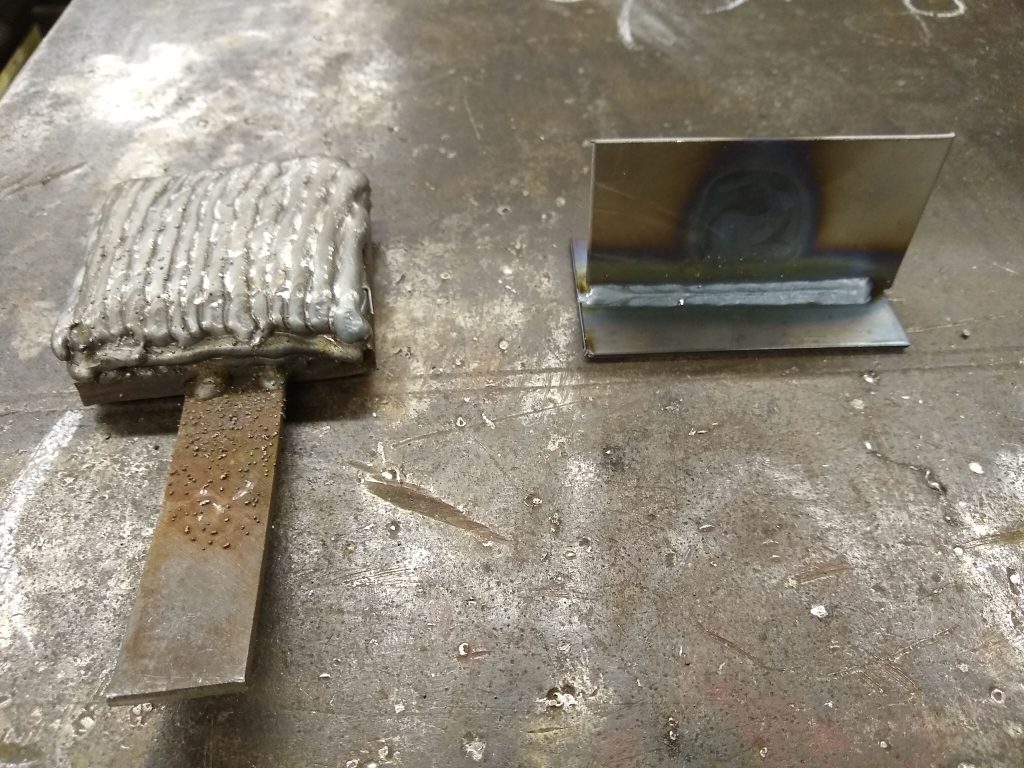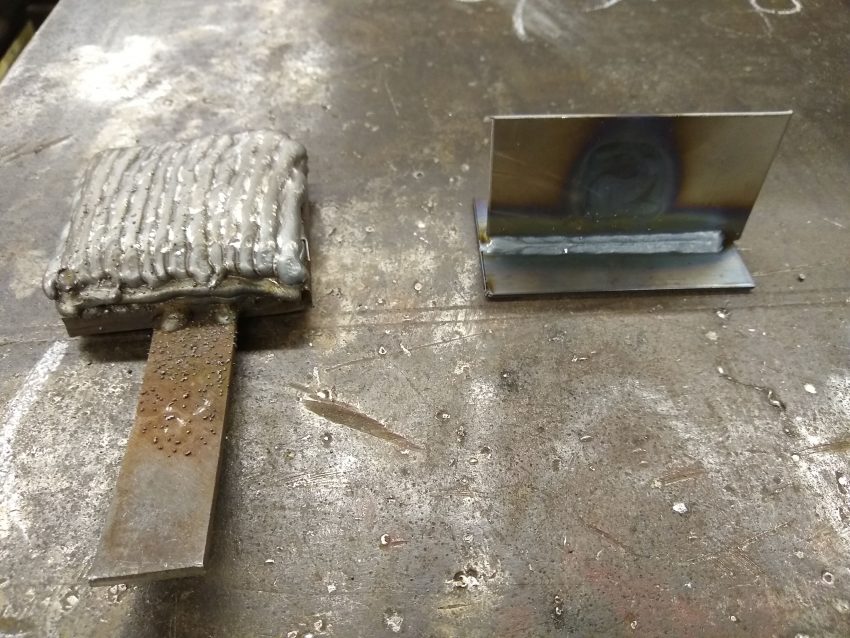The PAD Weld
The post below is a slight revision of a post from my Weldingclassroom.com site. I will identify the additions by italic and they will mainly be related to my additional experience as a High School Welding Teacher which started in the Fall of 2019. I have been blessed!
One of the 1st exercises I performed as a welding student in High School Welding Class was the pad weld. For the terminology police a “Surfacing Weld”. As a student back then, all I wanted to do was weld 2 pcs of metal together and try to break em. At that time, I didn’t realize how much this exercise built my skills.
I personally think the pad weld is one of the best exercises available for both building basic and advanced welding skills.
Specifically, the reasons are as follows.Ease of setup, high arc time, low cost, easy to evaluate, and builds bead placement skills.
Ease of Setup
I know that many instructors will have varying opinions on the importance of welding students being able to gather materials, cut, prep, and bevel them.
I think a need for supporting skills for welding exists, however, if I can primarily have students spend time on striking an arc vs do ANYTHING else, I do.
The manual dexterity skills of a welder are what separates us from other jobs. I want the primary focus on welding at all times. The other things are secondary. Yes, students may just be motivated by “Building” something cool like the schools latest project taken from industry with cheap labor and no overhead but sometimes those projects greatly hinder the welding time for students.
It is my hope as students continue in my classes, they will slowly work into projects after they have demonstrated welding skills that would be expected from an entry level welder in industry. I am not speaking of an entry level fabricator. Lets face it, manufacturing jobs require few fitting skills. High paying pipe welding jobs are usually but not always, interested in my ability to make a sound weld. Learning how to fit AND weld is great and depending on the needs of the industry, I may modify my thoughts in the future.
So to setup, I need a pc of flatbar maybe 2″x4″x1/4″, 3″x3 x 3/16″ or whatever size you like. I’m good to go. But really, any piece of material sitting around is suitable for welding a pad weld even if its already been welded on. If TIG welding, maybe some prep time removing mill scale if any exists.
Since the piece can be used many times, the daily setup is nothing other than getting your pc out and welding.
Compare that to the time needed to cut 2 pcs, tack em together, and weld 2 beads and throw it away. So if you’re in class or teaching a class and searching for some way to stay busy or keep students busy, the Pad Weld is always there. Even after their surfacing welds have been completed, graded, and they have moved on, having a pad weld handy can be used to start new skills.
Arc Time
With many processes, the majority of waste comes from what is normally referred to as “Production Factor”. This is a percentage of actual arc time in a given period of time. In a typical welding class during shop time, a production factor of 30% is about as good as it will ever get. When preparing materials for a single bead, tacking them together, and welding is all part of “shop time”, that factor will go down a great deal.
During the start of training with new welders, tasks as simple as just tacking a tee joint together can be a time-consuming process that results in a joint that often has only 2 to 6 beads run on it.
Additionally, the time chipping, cleaning, looking at a fillet weld may very likely be more than that time spent working on a bead on a pad weld. I’m not suggesting that tee joints are not needed, just when they are introduced. The key to developing the muscle memory and ability to see the puddle is repetition. The more you do it, the better you get. The quicker I can have something to weld on, the less time I spend prepping. Cleaning a bead on plate takes much less time than a fillet welded tee joint.
If I take the considerations above and add to that the fact that these are High School Students AND I have 2 students to a booth, production factor can go WAAAAY DOWN!
Low Cost
The pad weld exercise can use one pc of 2″x4″x1/4″ flat bar for 100 hours with no problem. I’m not saying that’s needed but its possible. If you count time as money, then the costs become even greater. Even after students have moved onto tee, lap, butt and corner joints, keeping the pad weld available for those times when materials aren’t available or maybe a new challenge is needed but spending money isn’t an option.
So even after a student has “mastered” the pad weld and moved on to fillet welds or groove welds, moving the pad to the floor or under the table can add a new dimension to the students experience. Even welding flat sitting on a floor can be a challenge compared to doing the same thing on a table.
Easy to Evaluate
Though a bead is a bead is a bead, looking at a fillet weld or bead in a multipass groove weld can involve more discussion with the student to talk about what is going wrong. If they haven’t developed basic skills maintaining work/travel angles and arc lengths then the fillet welds can be very difficult to evaluate what is really going on.
One of the key skills that are very easy to evaluate using a pad weld is the ability for the welder to control bead placement. A pad weld can be evaluated for how well the beads are placed without even looking at it. It could be just felt with the fingertips (after being cooled of course),
Bead Placement Skills
As mentioned above, the ability to evaluate how well the beads are is pretty simple. If the surface is smooth and consistent, then the welder is in control of where he/she puts the metal. If the hills and valleys vary from one part of the plate to another, then bead placement skills may not yet be fully developed. But how can a pad weld help with other welds?
Well, here is my theory. If a welder has the ability to run a single bead from point A to point B is any position and progression, then the next thing they need to control is WHERE they put the weld. It doesn’t matter if its a fillet weld or groove weld, they have to “follow a path” and be able to respond to changes in electrode length, surface contours, visibility, etc as they weld. As each bead gets placed, a slightly different “path” is laid down for the welder to follow OR make a decision to NOT FOLLOW in order to straighten things out.
As a student “Masters” his or her pad welding in normal positions, they can be challenged by relocating the pieces to increase difficulty.
The pad weld can be the core skill building exercise that can be done at any time. Similar to being an athlete that specializes in a single sport but still wants to build skills, reflexes, and coordination. They may do simpler tasks to maintain and build sharpness even though they are not like the “real thing”. Just think how sore your head would be if the only thing you could do to improve boxing skills was get out there and box with a real person.
Where is it useful besides learning?
Besides building skills for welding, there are applications in which being able to perform a “surfacing weld” with smooth layers is of great value.
In one case where it was of great value was while I was in the US Navy. We had one project that occurred on multiple tended units (submarines) that required an electric generator rotor to be removed from the boat, moved to the tender, and rewound, then returned to the boat for installation. The rotor was larger than the inside diameter of the aft escape hatch. The outside machine shop (38A) would setup a machine to cut the excess material from the ID of the aft escape hatch, the rotor was removed, rewound, and returned to the submarine. All of this took a good bit of the submarines “refit schedule”. So the subsequent weld build up and machining of the hatch was a critical part of the boat getting underway on time. The smoother the 300 series stainless steel buildup over the HY 80 hull was, the quicker the machining went. The ability to deposit those smooth consistent layers also made it easier to measure during welding and make sure there was enough but not so much welding time and machining time was wasted.
My 1st welding job after getting out of the Navy was at Lambs Machine Works in Memphis. This machine shop performed all kinds of machinery repairs. In many cases, buildup of worn sections was required and the surface finish of the buildup was critical.
Summary
Don’t underestimate the “bang for the buck” that is to be had by the “Pad Weld” it is one of the most time efficient ways to develop the connection from the arc to your hands through your eyes and brain, PERIOD! The manual dexterity developed by the ability to maximize the arc time during practice is unmatched by any other exercise.
Though it may be considered unchallenging by some, modification of the conditions in which its done can make it quite challenging. How about some mirror welded pad welds? Or would you rather the time to cut, prep, and fit some new pieces just to make a mess on them in just a minute or two?
MY Students Get Bored
I have considered the fact that doing the same weld every day can be rough. But I also know that this is not an 8 or 12 hour per day “Job” these students are welding at. It is about 5 or 10 hours per week. I can break up the monotony by changing positions, changing locations in booths, competitions, and allowing for Fillet Welds with no fillet weld practice. Here is the image from the post showing a fillet weld made by a student who had never practiced one.

As I move forward as a teacher, I hope to grow my ideas and improve those that are worthwhile and get rid of those that do not help my students. I welcome feedback from others on this topic and look forward to your comments.
